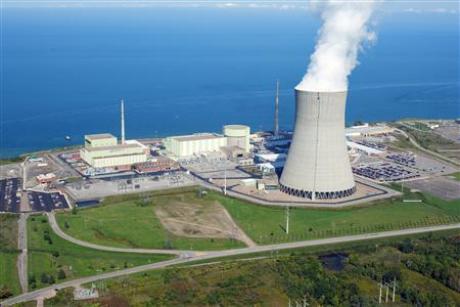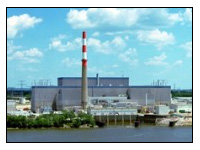July 04, 2013
By: John
Category: In The News
Comments Off on (ANS Cafe) Open Letter to Those Attending Global Power Shift and to the Climate Movement at Large
July 04, 2011
By: John
Category: In The News
Comments Off on 59th Carnival of Nuclear Blogs
October 11, 2010
By: John
Category: In The News

Nationally, power companies have seen plans for construction of new nuclear power facilities stalled, in response to a slow economy and lack of an appropriate stimulus. Two years ago, it seemed a done deal, that nuclear was on the comeback, yet today the lack of a national plan to respond to climate change, which includes a carbon tax, and lower demand puts new construction on hold, much as we are seeing in other sectors, according to one Nuclear Energy Institute spokesperson.
WASHINGTON — Just a few years ago, the economic prognosis for new nuclear reactors looked bright. The prospect of growing electricity demand, probable caps on carbon-dioxide emissions and government loan guarantees prompted companies to tell the Nuclear Regulatory Commission that they wanted to build 28 new reactors. [Read More] read more
Comments Off on Slow Economy Delays Nuclear Plans
December 28, 2009
By: John
Category: In The News
Please take a look at the recent article from Wired.com, on thorium reactors!
[ Link ]
Comments Off on Wired: Thorium Reactors
June 24, 2009
By: John
Category: In The News
![piketon[1] piketon[1]](http://nuclearactive.com/wp-content/uploads/2009/06/piketon1.jpg)
A new nuclear reactor facility has been proposed for Piketon, Ohio. The power reactor, presumed to be Areva’s 1600 MWe EPR, would be built on the very large site of the former uranium enrichment plant in Piketon, and would be owned and operated by Duke.
The proposed site is the location of the Portsmouth gaseous diffusion uranium enrichment plant, which operated from 1954 to 2001. The plant and its facilities were then kept in ‘cold standby’ until 2005, when they entered ‘cold shutdown’, and decontamination and decommissioning began. In 2004, US enrichment company USEC selected the Portsmouth site as the home of its American Centrifuge enrichment plant, currently under construction and due to begin commercial operations in 2010. read more
Comment (1)
June 24, 2009
By: John
Category: In The News
Babcock & Wilcox announced its intention to put smaller, rail-delivered 125 MW reactor modules, into production by 2018. These units are one-tenth the size of a typical nuclear plant, and this makes them suitable for rural and third-world applications. These reactors are rated for 60 years, with refueling every 5 years.
[Read the IEEE Spectrum article, here.]
Comments Off on mPower Reactor 125 MW Units Announced
June 15, 2009
By: John
Category: In The News
Source: NuclearStreet.com]
By Stephen Heiser -
 An approximate 38-megawatt increase in output at an Exelon Nuclear plant last week launched a series of planned power uprates across the company’s nuclear fleet that will generate between 1,300 and 1,500 megawatts of additional generation capacity within eight years without turning a spade of earth, Exelon Nuclear President and Chief Nuclear Officer Charles (Chip) Pardee said today.
An approximate 38-megawatt increase in output at an Exelon Nuclear plant last week launched a series of planned power uprates across the company’s nuclear fleet that will generate between 1,300 and 1,500 megawatts of additional generation capacity within eight years without turning a spade of earth, Exelon Nuclear President and Chief Nuclear Officer Charles (Chip) Pardee said today.
The first of the new, carbon-free nuclear megawatts was officially confirmed last week following equipment upgrades at Exelon’s Quad Cities nuclear plant near Cordova, Ill. Other uprate projects are underway and Exelon plans to have the full measure of new megawatts on the grid by 2017.
“With these uprates, we will be able to produce the equivalent output of a new advanced nuclear reactor, and we’ll bring it to market in a timeframe commensurate with the fastest new construction,†Pardee said. “These uprates are a critical component of Exelon 2020, the company’s plan to eliminate the equivalent of its 2001 carbon footprint by 2020.â€
Uprate projects improve the efficiency and increase electricity output of a nuclear generating unit through upgrades to plant equipment. The projects take advantage of new production and measurement technologies, new materials and learning from a half-century of nuclear power operations.
The remainder of uprate megawatts will come from additional projects at nine Exelon plants beginning in 2010 and ending in 2017.
At 1,500 nuclear-generated megawatts, the uprates would displace 8 million metric tons of carbon emissions annually that would otherwise come from burning fossil fuels.
Exelon operates the largest fleet of commercial nuclear reactors in the United States and the third largest in the world. A series of plant upgrades and uprates over the past 10 years have already added approximately 1,100 new megawatts to Exelon Nuclear’s generation.
Comments Off on Quad Cities Excelon Nuclear Plant Upgrade
June 11, 2009
By: John
Category: radiation safety
SNL video of an F-4 Phantom II (68,000 pounds) smashing into a section of reactor containment vessel at over 500 mph. The result is barely a scratch on the inside of the vessel. This is how modern nuclear reactors are built, with a six-foot wall of steel-reinforced concrete that can resist this kind of impact. Nuclear reactors are designed damn tough, to keep contamination inside in the worst case scenario. This is not how Chernobyl was designed, and this is why the results were disastrous. This is how Three-Mile Island reactor was designed, and that is why the nearby city was unaffected and the plant still operates today. Well-built reactors are safe to live by, and safer and cleaner than alternative fuel sources. read more
Comments Off on Sandia National Laboratory Tests
June 11, 2009
By: John
Category: radiation myths & misconceptions
Many people are eager to stop using fossil fuels, but they are very reluctant to accept that nuclear power can be a “greener” alternative. It’s true. Fossil fuels pump pollution and radiation into the atmosphere, but did you know that coal-fired plants release hundreds of times the radiation of a typical nuclear plant?
Here’s a study by ORNL on coal plant radiation releases:
http://www.ornl.gov/info/ornlreview/rev26-34/text/colmain.html
Comments Off on Comparing Contaminants
June 10, 2009
By: John
Category: In The News, Nonproliferation
[From IEEE Spectrum, Energy Wise.]
Two of the largest Japanese utilities, Kyushu Electric Power and Shikoku Electric Power, are preparing to fuel nuclear reactors with rods containing recycled plutonium starting this fall, John Boyd reports from Tokyo. In the middle of last month, two ships arrived from France with loads of mixed-oxide fuel (MOX) containing plutonium that originated in Japanese spent fuels, which Japan is contractually obligated to take back. The MOX consignment from France’s La Hague reprocessing complex weighed an estimated 1700 kilograms. read more
Comments Off on Japan Gets Set to Burn Plutonium


![piketon[1] piketon[1]](http://nuclearactive.com/wp-content/uploads/2009/06/piketon1.jpg)
 An approximate 38-megawatt increase in output at an Exelon Nuclear plant last week launched a series of planned power uprates across the company’s nuclear fleet that will generate between 1,300 and 1,500 megawatts of additional generation capacity within eight years without turning a spade of earth, Exelon Nuclear President and Chief Nuclear Officer Charles (Chip) Pardee said today.
An approximate 38-megawatt increase in output at an Exelon Nuclear plant last week launched a series of planned power uprates across the company’s nuclear fleet that will generate between 1,300 and 1,500 megawatts of additional generation capacity within eight years without turning a spade of earth, Exelon Nuclear President and Chief Nuclear Officer Charles (Chip) Pardee said today.
 Dr. John D. Johnson has a background in nuclear, experimental & accelerator physics. He worked for Los Alamos National Laboratory in the 1990s and founded Docent Institute to raise awareness about the ethical use of advanced technology.
Dr. John D. Johnson has a background in nuclear, experimental & accelerator physics. He worked for Los Alamos National Laboratory in the 1990s and founded Docent Institute to raise awareness about the ethical use of advanced technology.